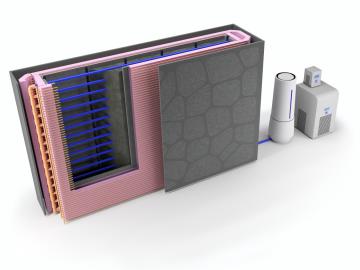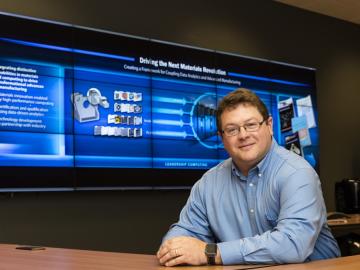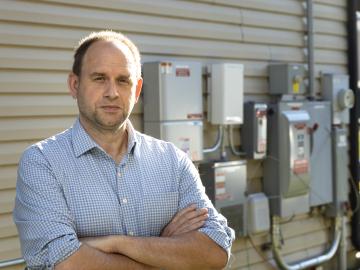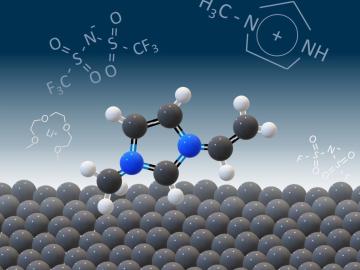
Filter News
Area of Research
- Advanced Manufacturing (16)
- Biological Systems (1)
- Biology and Environment (43)
- Building Technologies (1)
- Computational Biology (2)
- Computational Engineering (2)
- Computer Science (9)
- Electricity and Smart Grid (3)
- Energy Science (135)
- Energy Sciences (1)
- Functional Materials for Energy (2)
- Fusion and Fission (6)
- Fusion Energy (1)
- Isotopes (6)
- Materials (52)
- Materials for Computing (10)
- Mathematics (1)
- National Security (17)
- Neutron Science (22)
- Nuclear Science and Technology (3)
- Quantum information Science (8)
- Sensors and Controls (1)
- Supercomputing (56)
News Type
News Topics
- (-) 3-D Printing/Advanced Manufacturing (106)
- (-) Big Data (66)
- (-) Biomedical (57)
- (-) Clean Water (30)
- (-) Energy Storage (79)
- (-) Grid (57)
- (-) Machine Learning (53)
- (-) Mercury (10)
- (-) Polymers (23)
- (-) Quantum Science (62)
- Advanced Reactors (30)
- Artificial Intelligence (100)
- Bioenergy (90)
- Biology (106)
- Biotechnology (28)
- Buildings (57)
- Chemical Sciences (59)
- Composites (25)
- Computer Science (169)
- Coronavirus (34)
- Critical Materials (18)
- Cybersecurity (23)
- Education (2)
- Emergency (4)
- Environment (178)
- Exascale Computing (54)
- Fossil Energy (7)
- Frontier (48)
- Fusion (56)
- High-Performance Computing (104)
- Hydropower (12)
- Irradiation (3)
- Isotopes (46)
- ITER (8)
- Materials (118)
- Materials Science (109)
- Mathematics (11)
- Microelectronics (3)
- Microscopy (42)
- Molten Salt (8)
- Nanotechnology (41)
- National Security (70)
- Neutron Science (122)
- Nuclear Energy (98)
- Partnerships (43)
- Physics (44)
- Quantum Computing (41)
- Security (20)
- Simulation (55)
- Software (1)
- Space Exploration (24)
- Statistics (3)
- Summit (50)
- Transportation (77)
Media Contacts

Oak Ridge National Laboratory researchers used additive manufacturing to build a first-of-its kind smart wall called EMPOWER.

The Department of Energy has selected Oak Ridge National Laboratory to lead a collaboration charged with developing quantum technologies that will usher in a new era of innovation.

It’s a new type of nuclear reactor core. And the materials that will make it up are novel — products of Oak Ridge National Laboratory’s advanced materials and manufacturing technologies.

The Society of Manufacturing Engineers, known as SME, has named William Peter, director of Oak Ridge National Laboratory’s Manufacturing Demonstration Facility in the Energy and Environmental Sciences Directorate, among its 2020 College of SME Fellows.

Pick your poison. It can be deadly for good reasons such as protecting crops from harmful insects or fighting parasite infection as medicine — or for evil as a weapon for bioterrorism. Or, in extremely diluted amounts, it can be used to enhance beauty.

Oak Ridge National Laboratory researchers have developed a machine learning model that could help predict the impact pandemics such as COVID-19 have on fuel demand in the United States.

Joe Hagerman, ORNL research lead for buildings integration and controls, understands the impact building technology innovations can have during times of crisis. Over a decade ago, he found himself in the middle of one of the most devastating natural disasters of the century, Hurricane Katrina.

Scientists seeking ways to improve a battery’s ability to hold a charge longer, using advanced materials that are safe, stable and efficient, have determined that the materials themselves are only part of the solution.

ORNL researchers have developed an intelligent power electronic inverter platform that can connect locally sited energy resources such as solar panels, energy storage and electric vehicles and smoothly interact with the utility power grid.

From materials science and earth system modeling to quantum information science and cybersecurity, experts in many fields run simulations and conduct experiments to collect the abundance of data necessary for scientific progress.


